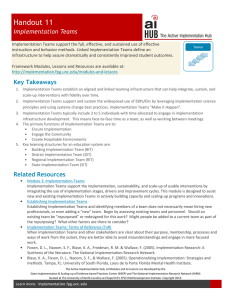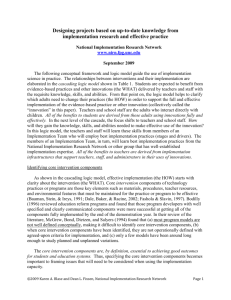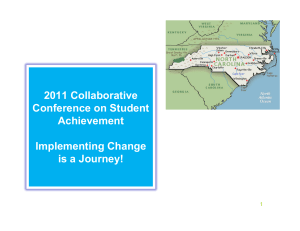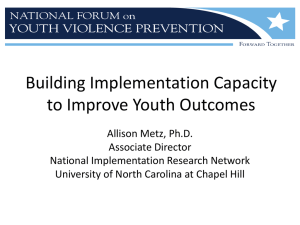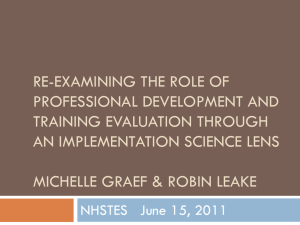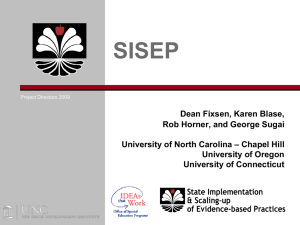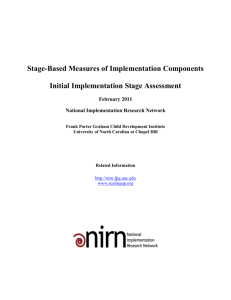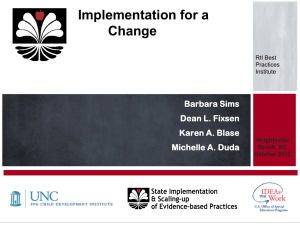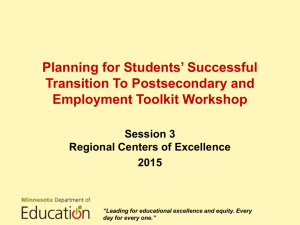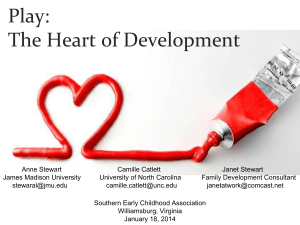T Implementation Brief Implementation: The Missing Link Between Research and Practice
advertisement
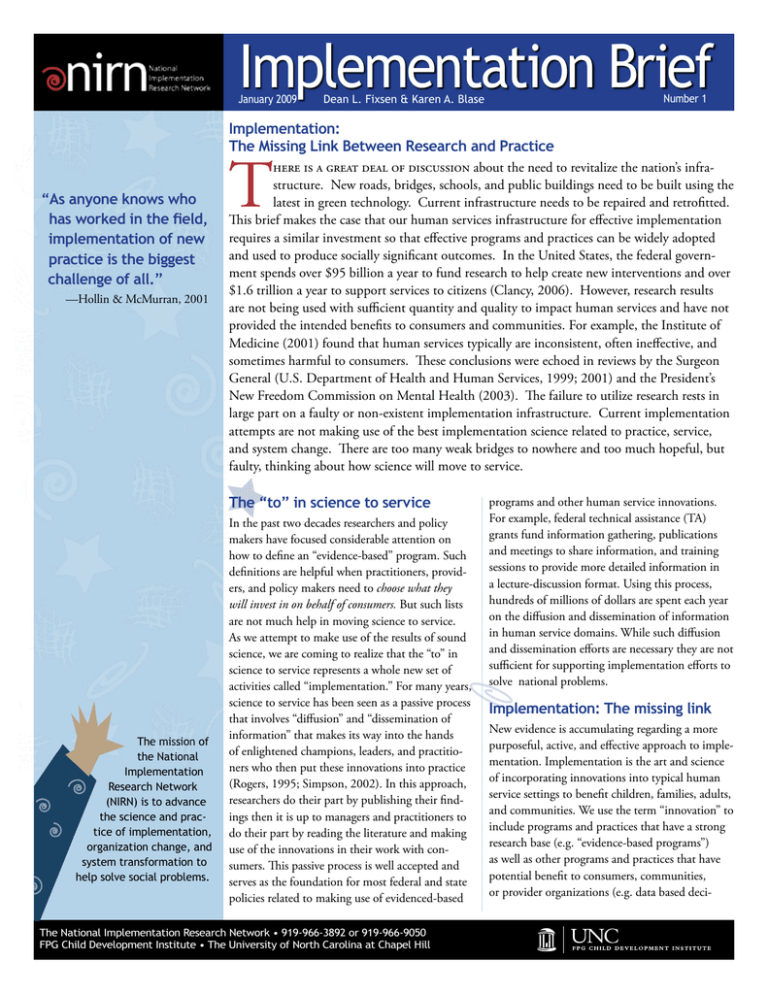
Implementation Brief January 2009 Number 1 Dean L. Fixsen & Karen A. Blase Implementation: The Missing Link Between Research and Practice “As anyone knows who has worked in the field, implementation of new practice is the biggest challenge of all.” —Hollin & McMurran, 2001 T here is a great deal of discussion about the need to revitalize the nation’s infrastructure. New roads, bridges, schools, and public buildings need to be built using the latest in green technology. Current infrastructure needs to be repaired and retrofitted. This brief makes the case that our human services infrastructure for effective implementation requires a similar investment so that effective programs and practices can be widely adopted and used to produce socially significant outcomes. In the United States, the federal government spends over $95 billion a year to fund research to help create new interventions and over $1.6 trillion a year to support services to citizens (Clancy, 2006). However, research results are not being used with sufficient quantity and quality to impact human services and have not provided the intended benefits to consumers and communities. For example, the Institute of Medicine (2001) found that human services typically are inconsistent, often ineffective, and sometimes harmful to consumers. These conclusions were echoed in reviews by the Surgeon General (U.S. Department of Health and Human Services, 1999; 2001) and the President’s New Freedom Commission on Mental Health (2003). The failure to utilize research rests in large part on a faulty or non-existent implementation infrastructure. Current implementation attempts are not making use of the best implementation science related to practice, service, and system change. There are too many weak bridges to nowhere and too much hopeful, but faulty, thinking about how science will move to service. The “to” in science to service The mission of the National Implementation Research Network (NIRN) is to advance the science and practice of implementation, organization change, and system transformation to help solve social problems. In the past two decades researchers and policy makers have focused considerable attention on how to define an “evidence-based” program. Such definitions are helpful when practitioners, providers, and policy makers need to choose what they will invest in on behalf of consumers. But such lists are not much help in moving science to service. As we attempt to make use of the results of sound science, we are coming to realize that the “to” in science to service represents a whole new set of activities called “implementation.” For many years, science to service has been seen as a passive process that involves “diffusion” and “dissemination of information” that makes its way into the hands of enlightened champions, leaders, and practitioners who then put these innovations into practice (Rogers, 1995; Simpson, 2002). In this approach, researchers do their part by publishing their findings then it is up to managers and practitioners to do their part by reading the literature and making use of the innovations in their work with consumers. This passive process is well accepted and serves as the foundation for most federal and state policies related to making use of evidenced-based The National Implementation Research Network • 919-966-3892 or 919-966-9050 FPG Child Development Institute • The University of North Carolina at Chapel Hill programs and other human service innovations. For example, federal technical assistance (TA) grants fund information gathering, publications and meetings to share information, and training sessions to provide more detailed information in a lecture-discussion format. Using this process, hundreds of millions of dollars are spent each year on the diffusion and dissemination of information in human service domains. While such diffusion and dissemination efforts are necessary they are not sufficient for supporting implementation efforts to solve national problems. Implementation: The missing link New evidence is accumulating regarding a more purposeful, active, and effective approach to implementation. Implementation is the art and science of incorporating innovations into typical human service settings to benefit children, families, adults, and communities. We use the term “innovation” to include programs and practices that have a strong research base (e.g. “evidence-based programs”) as well as other programs and practices that have potential benefit to consumers, communities, or provider organizations (e.g. data based deci- sion support systems, electronic record systems, targeted fund raising approaches, skill-based hiring methods). Recently, a comprehensive review of the implementation evaluation literature and current successful practices was completed and a synthesis of that information resulted in new ways to view the methods needed to make better use of science in typical human service settings (Blase & Fixsen, 2003; Blase, Fixsen, Naoom, & Wallace, 2005; Fixsen, Naoom, Blase, Friedman, & Wallace, 2005; Wallace, Blase, Fixsen & Naoom, 2008). From an implementation point of view, doing more and better research on a program or practice itself does not lead to more successful implementation. A series of meta-analyses and detailed assessments of the strength of research findings for certain practices and programs may help a consumer, agency, or community select a program. However, more data on program outcomes will not help implement that program with fidelity and benefits for the intended recipients. “Discovering what works does not solve the problem of program effectiveness. Once models and best practices are identified, practitioners are faced with the challenge of implementing programs properly. A poorly implemented program can lead to failure as easily as a poorly designed one” (Mihalic, Irwin, Fagan, Ballard, & Elliott, 2004). Results from the synthesis of the implementation literature and best practices yielded two major theoretical frameworks that can guide practice and research efforts to move science to service more effectively and efficiently. The first framework describes the stages of implementation. The second framework provides a view of the core components of implementation. Stages of Implementation The literature is clear that implementation is a process that takes two to four years to complete in most provider organizations. It is a recursive process with steps that are focused on achieving benefits for children, families, provider organizations, human service systems, and communities. It appears there are six functional stages of implementation: exploration, installation, initial implementation, full implementation, innovation, and sustainability. The stages are not linear as each impacts the other in complex ways. For example, sustainability factors are very much a part of exploration and full implementation directly impacts sustainability. Or, an organization may move from full implementation back to initial implementation in the midst of unusually high levels of staff turnover. National Implementation Research Network Core Implementation Components Based on the commonalities among successfully implemented programs across many fields, core implementation components have been identified (Fixsen et al., 2005). The goal of implementation is to have practitioners (e.g. foster parents, caseworkers, therapists, teachers, physicians) use innovations effectively. To accomplish this, high-fidelity practitioner behavior is created and supported by core implementation components (also called “implementation drivers”). These components are staff selection, pre-service and in-service training, ongoing coaching and consultation, staff performance evaluation, decision support data systems, facilitative administrative supports, and system interventions. These interactive processes are integrated to maximize their influence on staff behavior and organizational functioning. The interactive core implementation components also compensate for one another in that a weakness in one component can be overcome by strengths in other components. Conclusion Stages of Implementation and stage-related work together with effective use of the Core Implementation Components are two key frameworks for creating an effective implementation infrastructure. We need to build, utilize, and evaluate implementation infrastructures and strategies if we are to achieve significant outcomes for consumers and communities. We must learn how to implement well-researched programs and practices effectively on a national scale. In their report of findings from the Blueprint Replication Initiative, Elliott and Mihalic (2004) stated that although ten Blueprint programs studied had completed the necessary efficacy and effectiveness trials and had met the rigorous evaluation standards required for certification as a Blueprint program, they were not prepared to deliver their programs on a useful scale. Only four of the ten programs had the organizational capacity to deliver their program to ten or more new sites a year. According to the authors, “Although we have taken giant strides in determining what works and promoting the use of science-based programs, we have lagged behind in building the internal capacity of designers to deliver their programs” (Elliott & Mihalic, 2004, p. 48). Building implementation infrastructure, effective implementation and scale-up strategies, and capacity is an international priority if we are to reap full advantage from the evidence based program movement. The bridge from science to service must be built, repaired, maintained and improved. Impealercmh:entation Res sis A Synthethe of tu Litera re Dean L. Fixsen m Sandra F. Naoo Karen A. Blase man Robert M. Fried ce Frances Walla Implemrch:entation Resea A Synthesis of the Literature Implementation Research: A Synthesis of the Literature Dean L. Fixsen Sandra F. Naoom Karen A. Blase Robert M. Friedman Frances Wallace All references included in this document can be found at http://www.fpg.unc. edu/~nirn/resources/ publications/Monograph/ Suggested citation: Fixsen, D. L., & Blase, K. A. (2009, January). Implementation: The missing link between research and practice. NIRN Implementation Brief #1. Chapel Hill: The University of North Carolina, FPG, NIRN. For further information: Dean L. Fixsen fixsen@mail.fpg.unc.edu Karen A. Blase blase@mail.fpg.unc.edu National Implementation Research Network, or visit http://nirn.fpg.unc.edu http://nirn.fpg.unc.edu
